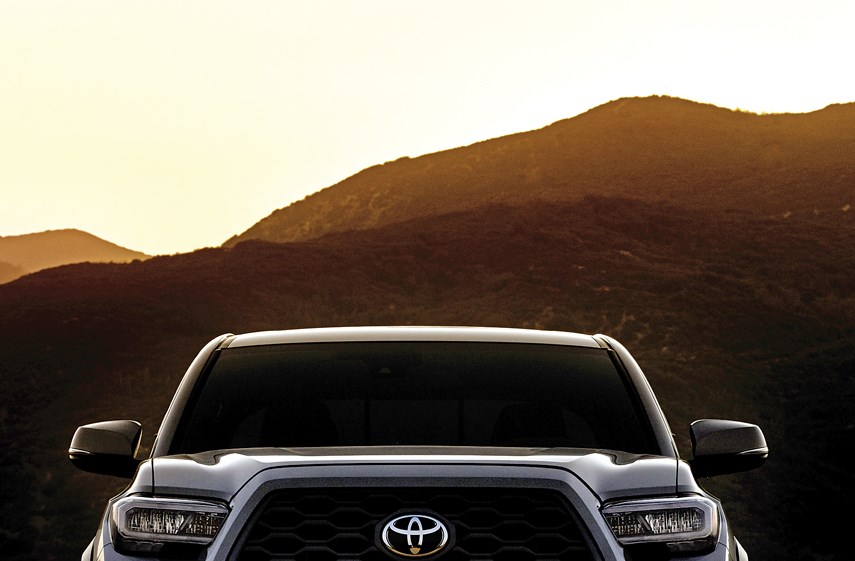A biweekly roundup of automotive news, good, bad and just plain weird:
New Tacoma headed to Chicago Auto Show
Ordinarily, a single teaser image would hardly rate as news. The Toyota Tacoma, however, is so much a part of North Shore life that it should be on the coat-of-arms of all three municipalities.
Thus, Toyota’s decision to leak out a single image, dimly lit and heavily cropped, is probably worth poring over for clues. Looking closely, Tacoma fans will be able to see reworked headlights and a smoother roofline.
Let’s face it, Toyota is unlikely to make any major changes to the Tacoma. A large part of the truck’s appeal is the way it is only ever mildly tweaked. Resale values stay high, and that drives new sales.
However, with Jeep now offering the Wrangler-based Gladiator pickup, the return of the Ford Ranger, and GM’s Colorado and Canyon trucks, the Tacoma can’t afford to rest on its laurels. Perhaps Toyota will finally see fit to cram one of its world market diesel engines under the hood? We’ll have to wait until next week to find out.
The end of the unrestricted Autobahn?
For decades, the German Autobahn has been synonymous with high-speed travel. Not all of it is unrestricted, but there are sections where the only limit is the amount of traffic in front of you, and the amount of horsepower under the hood.
How Germany’s been able to get away without putting a cap on speeds mostly relates to well-tended infrastructure, and well-trained drivers. German motorists display excellent lane-discipline, moving smartly to the right when not executing a passing manoeuvre. Imagine living in a place where people didn’t clog up the passing lane at ten kilometres per hour under the speed limit. Dare to dream.
However, travelling at high speed in an automobile has diminishing rates of return. The faster you go, the more air you have to push, and the worse your fuel economy gets. With European standards concerned about greenhouse gas emissions, a recent poll showed that a slight majority of Germans favoured putting a cap on Autobahn speeds.
Setting limits of between 120-140 kilometres per hour split those polled, with 54 per cent in favour and 46 per cent against. That’s almost too close to call, and Germany’s conservative transport minister, Andreas Scheuer, was quick to shrug off the poll as more micro-management. Dropping speed limits might only reduce Germany’s emissions by 0.5 per cent.
Still, the poll shows that unlimited highway speeds aren’t universally beloved, even in a country where they’ve been part of life for decades. If you were going to pop over and rent a BMW for one last blast, better not wait too long.
Swedish automakers join forces
Do you have fond memories of Saab? I do. While I never actually owned one, I always appreciated how different the company was from occasionally stodgy Volvo. A Saab was wonderfully weird, often very quick, and always different from the usual German competition.
However, GM ran Saab firmly into the ground several years ago, and while the company’s corpse still twitches from time to time, you can’t currently go out and buy one. You can, if you’ve got deep pockets, buy a Koenigsegg, a blue-blooded Swedish supercar. Now, Koenigsegg and Saab are set to work together.
The joint move is centred around electric vehicles, with both parties investing millions. NEVS, the Chinese company that bought the remains of Saab some years ago, has production bases in Sweden and China. Koenigsegg has performance brand recognition and engineering expertise.
No, it doesn’t sound like you’ll be able to buy a quirky hatchback or wagon any time soon. However, there’s room to play in this segment, and the Swedes are especially good at interiors.
Study: steering wheels are gross
Warning: do not read this one right after lunch. Or right before lunch.
A study funded by a car renting website is reporting that the average steering wheel is a disgusting mass of teeming bacteria. According to the study, the amount of bacteria on the average steering wheel is roughly double that found on the average public toilet. The study also noted that 20 per cent of people ate in their cars. Ew.
If you’ve just run in from frantically scrubbing down every surface in your car, don’t stop there. The study also took samples from gas station pumps, and noted that the average amount of bacteria found here was 4,000 times dirtier than the average steering wheel. Maybe opting for the full service option isn’t such an extravagance.
Watch this space for all the best and worst of automotive news, or submit your own auto oddities to [email protected].



